Question
A fabrication shop makes two types of valve actuators for explosive environments call them A and B. This actuator requires special manufacturing processes so there
A fabrication shop makes two types of valve actuators for explosive environments call them A and B. This actuator requires special manufacturing processes so there is one production line dedicated exclusive to producing them. The line consists of three workstations (w/s 1, w/s 2, and w/s 3). Demand for actuators is robust so you can assume that all are sold as soon as they are produced. Your task is to find the right mix of actuators to produce that maximizes profit.
Production of both types of actuators uses the same linear routing: raw materials goes to w/s 1; output of w/s 1 goes to w/s 2; output of w/s 2 goes to w/s 3. At this point the actuators are completed and go to pack and ships. Details of the processing times are provided in the technology table below along with the total number of hours available at each w/s and the profit realized for selling an actuator of each type.
| w/s 1 (hours) | w/s 2 (hours) | w/s 3 (hours) | Profit /actuator ($) | |
| Type A | 16.5 | 10.0 | 1.6 | 875 |
| Type B | 8.5 | 13.0 | 1.7 | 800 |
| Time available (hours) | 150 | 137 | 22.5 |
One member of the management team doesnt trust math models and loudly proclaim the obvious answer is to produce the maximum number of Type A actuators and discontinue Type B because As are the most profitable. He argues that even if the model says something different, it is because the analyst is playing with the numbers to make it say what they want it to say. You need to address this because this person is somewhat influential in addition to being loud.
a) Compute the maximum number of Type A actuators that can be made and stay within the time constraints of all workstations. What is the profit? For completeness, do the same calculations if you only produce Type B actuators?
b) Now, use linear programming to find the solution that maximizes profit. For now, assume that we can produce fractions of actuators so the number to produce can be a continuous variable and we can use the methodology covered in the lessons. To find the number of Type A and Type B actuators that will maximize profit, perform the following step: Write the model in equation form. Let xA and xB be the number of actuators of type A and B to produce, respectively. Hint: You model will look something like problems 1 and 2. If z is the total profit the it will be equal to the profit gained from producing xA units of Type A plus the profit gained from producing xB units of Type B. There will be constraints for the each of the w/ss that ensure the time used to produce xA and xB is less than the total time available. Solve the model graphically for x* = ( * A x , * B x ) Compute the optimal profit (z*) that corresponds to x*. Compare this answer with your answers in part a) and note what you find. Which solution has the higher profit? What differences do you see in how the solutions utilize the w/ss?
c) Sometimes rounding up and down from the optimal solution of the relaxed problem (i.e., assuming variables that are really integers are continuous) doesnt give you the optimal solution to the real/integer problem and sometimes it does. Conceptually, the reason is because you might be able utilize the constrained resources better a bit further from the optimal solution to the relaxed problem than just rounding up and down. In practical problems, it frequently doesnt matter much but it is an important point for you to understand because when profit margins are close, a little improvement can mean a lot. Anyway, you are now being asked to find the optimal integer solution using brute force enumeration using a spreadsheet that has six columns:
| Type A | Type B | w/s 1 | w/s 2 | w/s 3 | Profit |
Use the first two columns to identify all possible solutions. Vary the number of Type A actuators from 3 to 10 and, for each number of Type A actuators, vary the number of Type B actuators from 3 to 11. That is, there will be 72 rows with the first two columns (Type A, Type B) = (3,3), (3,4), (3,5), (10,11).
Use columns 3 through 5 to determine if the solution is feasible. To do this, compute the time required for the workstation to produce the actuations in the first two columns requires. Then check to see each is less than the maximum available. (You can use an IF statement if you know how they work or do the checking by hand.) You should be able to do this for the first row/solution, then copy and paste for the rest. Identify any rows that are infeasible by highlighting the cells in those rows.
For the feasible solutions, compute the profit and identify the one that is the maximum. Is this solution n rounded up and/or down from the one is part b? Any thoughts on this?
Step by Step Solution
There are 3 Steps involved in it
Step: 1

Get Instant Access to Expert-Tailored Solutions
See step-by-step solutions with expert insights and AI powered tools for academic success
Step: 2

Step: 3

Ace Your Homework with AI
Get the answers you need in no time with our AI-driven, step-by-step assistance
Get Started


